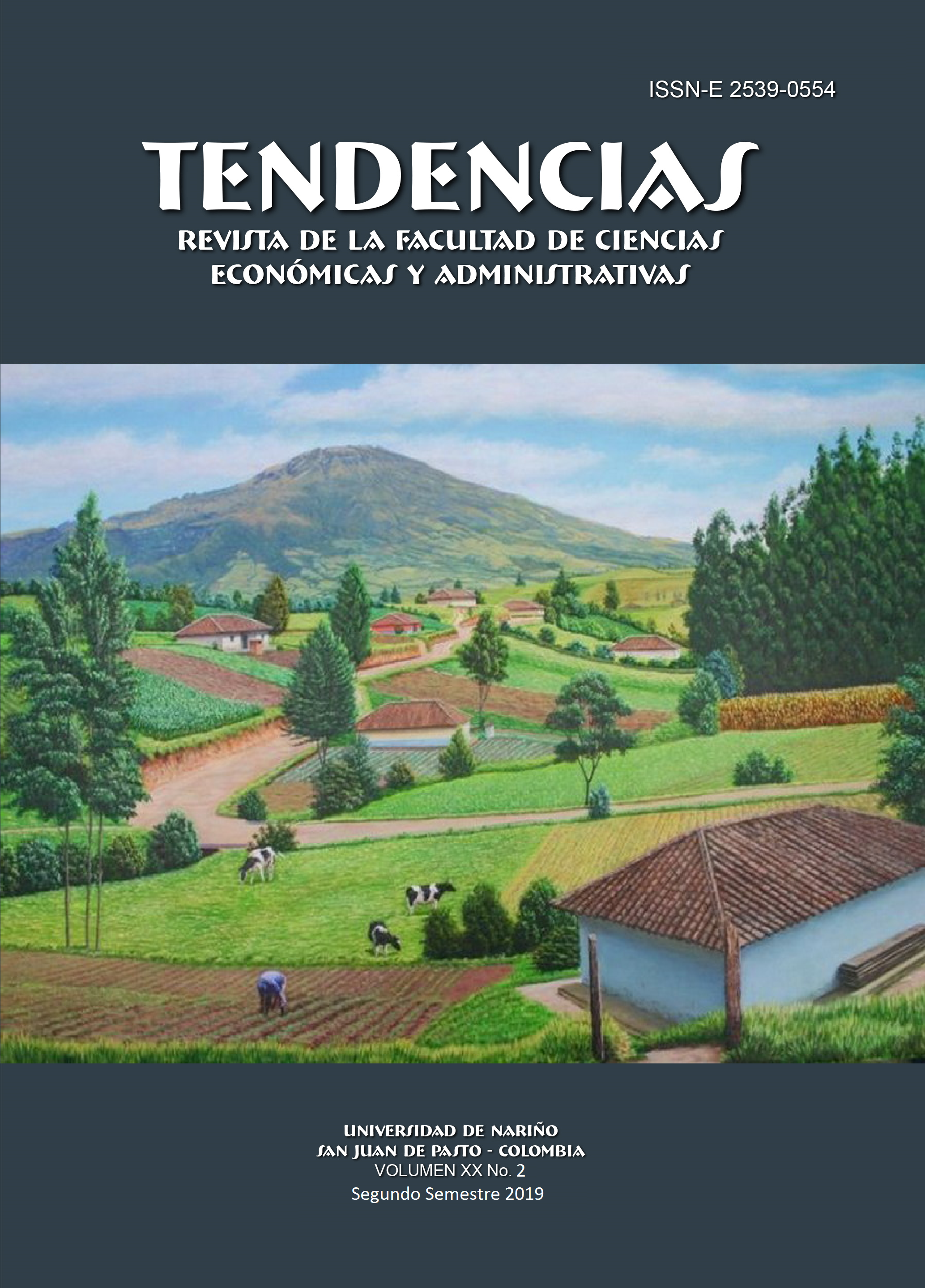Knowledge management practices in third sector organizations (ngos): case study
DOI:
https://doi.org/10.22267/rtend.192002.122Keywords:
knowledge management, NGOs, case study, organizations, third sectorAbstract
This paper aims to empirically verify knowledge management practices in a third sector organization (NGO). Non-governmental organizations are increasingly important, since they manage to meet unmet social needs; therefore, the study of their knowledge management practices is significant to support the improvement of their management. This article addresses a case study; the research approach is qualitative, descriptive and semi-structured interviews were applied to the collection of information. The case study is the Carlos Portela Foundation, an organization recognized in the Valle del Cauca (Colombia), for its work in support of children with cancer and their families. The results obtained in the study show that the Carlos Portela Foundation develops practices of acquisition, socialization, storage, distribution and use of knowledge, which for the most part lack a formally established structure. This situation can be explained mainly because there is no clarity of what it means to manage knowledge and the benefits, opportunities and potentials that this activity represents for the development of organizations.
Downloads
References
(1) Alavi, M; & Leidner, D. (2001). Knowledge management and knowledge management systems: conceptual foundations and research issues. MIS Quarterly, 25(1), 107-136.
(2) Asprilla, V. (2014). La Gestión Del Conocimiento Como Desafío Para Las Organizaciones Del Tercer Sector: Una Aproximación Teórica. Encuentro Internacional de Investigadores en Administración 2014. http://administracion.uexternado.edu.co/encuentroInvestigacion/plantillas/2014/MemoriasEncuentroInvestigacion2014.pdf
(3) Borga, F; Lettieri, E; & Savoldell, A. (2003). Knowledge management for no profit sector: methodologies and findings. Third European conference on knowledge management.
(4) Castillo, M. (2005). Metodología de investigación científica USN. Método de estudio de caso. Recuperado de: https://www.usn.edu.mx/site/index.php?option=com_content&view=article&id=162:metodo-de-estudio-de-caso&catid=86:mtodologia&Itemid=124
(5) Cullom, C; & Cullom, R. (2011). "Knowledge Management for Nonprofits: A Strategy for Organizational Sustainability," Communications of the IIMA: Vol. 11: Iss. 2, Article 2.
(6) Drucker, P. (2003). La Gestión del Conocimiento. Madrid: Ediciones Deusto.
(7) Edvardsson, I.R. (2008). HRM and Knowledge management. Employee Relations, 30(5), 553-561.
(8) Eisenhardt K; & Graebner M. (2007). Theory Building From Cases: Opportunities And Challenges. Academy of Management Journal, 50(1), 25–32.
(9) Fantova, F. (2006). Aproximaciones a la intervención social. Recuperado el 08 de noviembre de 2014: www.fantova.net
(10) Fundación Carlos Portela (2017). Quienes Somos. Cali, Colombia: Fundación Carlos Portela. Recuperado de: http://fundacarlosportela.org/
(11) Galvis, E; & Sanchez, J. (2013). A critical review of knowledge management in software process reference models. JISTEM J.Inf.Syst. Technol. Manag. 10(2).
(12) González, A; Joaquí, C; & Collazos, C. (2009). Karagabi kmmodel: modelo de referencia para la introducción de iniciativas de gestión del conocimiento en organizaciones basadas en conocimiento, Ingeniare, Revista Chilena de Ingeniería, 17(2), 223-225.
(13) Hedlund, G. (1994). A Model of Knowledge Management and the N-Form Corporation. Strategic Management Journal. 15, pp. 73-91.
(14) Hernández, R; Collado, C; & Baptista, M. (2014). Metodología de la investigación. México: McGraw-Hill.
(15) Herrera, M. (1998). La especificidad organizativa del tercer sector: Tipos y dinámicas, Revista Papers, (56), 163-196.
(16) Kaplan, R; & Norton, D. (2007). Using the Balanced Scorecard as a strategic management system. Harvard Business Review, 85 (7-8), 150-161.
(17) Kumar, K; Jain, K; & Tiwary, R. (2013). Leadership activities and their impact on creating knowledge in organizations. International Journal of Leadership Studies, 8(1), 15-27.
(18) López, W. (2013). El estudio de casos: una vertiente para la investigación educativa. Educere, 17(56), 139-144.
(19) Nonaka, I; & Takeuchi, H. (1999). La Organización creadora de conocimiento. Cómo las compañías japonesas crean la dinámica de la innovación. México, D. F.: Oxford University Press.
(20) Observatorio del Tercer Sector de Bizkaia. (2012). Gestionando el conocimiento para transformar la realidad. Recuperado el 02 de junio de 2014: http://www.3sbizkaia.org/Archivos/Documentos/Enlaces/1377_Reflexi%C3%B3n%20Inicial.pdf.
(21) OCDE. (2008). La evaluación del desarrollo económico y del empleo a nivel local. México: Programa LEED de la OCDE.
(22) Pava, L. (2008). Competencias laborales de trabajadores sociales en el tercer sector de la economía, Revista Tendencias & Retos, (13), 125-138.
(23) Polanyi, M. (1997). Personal knowledge: Towards a post-critical philosophy. London, UK: Routledge.
(24) Rivero, A; & Díaz, M. (2008). La interdisciplinariedad en la organización de los Procesos institucionales. Acimed. 18(6).
(25) Senge, P. (1990). The Fifth Discipline: The art and practice of the learning organization. New York: Doubleday.
(26) Stankosky M; & Baldanza C. (2001). A system approach to engineering a knowledge management system. En: Barqu’in et. al. Knowledge management . The catalyst for electronic government. Part II: Setting stage for electronic government.
(27) Tobar, F; & Fernández, C. (2000). Organizaciones solidarias: Innovación y gestión en el Tercer Sector. Buenos Aires. Lugar editorial.
(28) Willig, C. (2001). Introducing qualitative research in psychology. Adventures in theory and method. New York: Open University Press.
Published
How to Cite
Issue
Section
License
Those authors who have publications with this journal, accept the following terms:
This journal is licensed under a Creative Commons Reconocimiento-NoComercial 4.0 Internacional License. The articles can be copied, distributed, adapted and communicated publicly, as long as the credits of the work are recognized and the respective source is quoted. This work can not be used for commercial purposes.
To increase their visibility, documents are sent to databases and indexing systems.
The content of the items is the responsibility of each author, and does not compromise in any way, journal or institution.







































